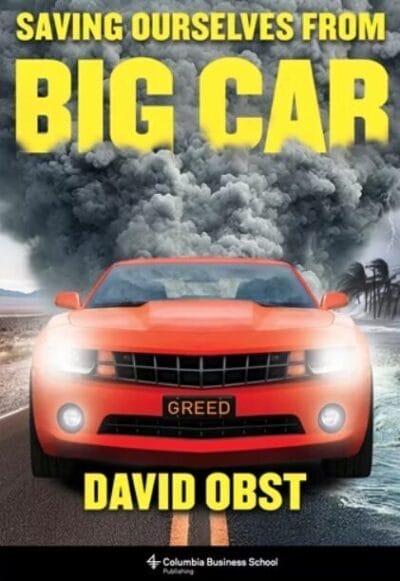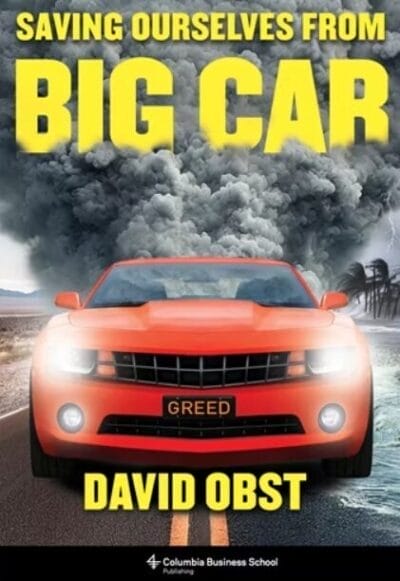
This article has been adapted from Saving Ourselves from Big Car by David Obst (Columbia University Press/Columbia Business School Publishing, September 16, 2025) It is provided courtesy of the publisher. https://cup.columbia.edu/book/saving-ourselves-from-big-car/9780231210423/
How Big Car Took Over The World (Part One)
In The Beginning…
In 1885, no human being had ever seen an automobile. The number of cars on the planet was zero. In 2024, the one billionth car will join our earth’s traffic jams. The most amazing thing about that number is that nobody planned it. We all just let it happen. We quickly and happily adjusted to the world that Big Car created for us. They caused us to move into cities, then leave our cities and move to the suburbs. They became a world-accepted method of showing one’s status. We began caring as much about our cars as we did our families. With very little resistance, we allowed Big Car to take over our economies and our lives. In the name of mobility, we changed how humans lived. We became addicted.
Here’s how it happened.
It started around 3500 BCE when some genius invented the wheel. The fact that humans had existed for hundreds of thousands of years without the wheel is often forgotten. One of the most interesting things about humans is how long it took us to come up with the modern standards we now use to meet our transportation needs. For most of the time humans have spent on the planet, we were able to live without needing to roll.
The entire concept of time and distance we now live by would be incomprehensible for most humans who lived in that pre-wheel world. The distances between peoples, although not at all geographically great, were still vast. Spending generations within the confines of your own immediate space was how most humans lived. Travel was expensive, time-consuming, and most importantly, dangerous. People traveled sometimes because they were pulled by the lure of easier and more profitable ways of living. More often, they traveled because they were pushed and pulled by disease, natural disasters, or—most likely—other humans wanting to take their stuff.
Another distinctive trait of humans is that they like their own spaces. To find those spaces often necessitated going to new uninhabited territories. That meant having to travel. At first, all travel was done on foot. If you were lucky enough to own a horse,then you traveled on horseback. Later, another genius figured out that horses and wheels could work together. He invented the buggy, which evolved into the carriage.
The carriage became the must-have vehicle for the privileged few. By the sixteenth century, it was the status symbol of the ruling classes. Every European city was soon brimming with ornate, opulently decorated vehicles. The traffic jam had been invented, especially in bad weather.
These early carriages were on four wheels and were drawn by two to four horses. Short-distance travel became cheap and convenient for much of the nineteenth and early twentieth centuries.You could buy your two-wheeled buggy for between $25 and $50 in today’s dollars. Buggies could easily be hitched and driven by untrained men, women, and even children. Hundreds of different buggy companies competed for market share. The wide use of buggies led to the grading and graveling of main rural roads and the paving of streets in many cities.
All of this continued until the start of the twentieth century. More and more of the world’s population was moving into metropolitan centers, except they now all faced the same daunting problem: transportation was dominated by horses, and horses relieve themselves whenever and wherever they feel the urge.
This had always been a problem for cities, but with population growth came an increase in the number of horses needed.
By the end of the nineteenth century, London had over 300,000 horses a day coming into town. New York City had 150,000, and these beasts produced more than two thousand tons of manure daily! Add to that a quart of urine from each nag,and you now had every street in your cities reeking of horse filth. Rain only made matters worse. Tens of thousands of city folk died each year from the effect of these horse droppings turning into fine dust and entering human lungs. The world’s cities had become smelly, uncomfortable, and unpleasant to live in.
Unfortunately, cities were where the jobs were. It was where you could make money much faster than laboring in the fields.The result was a fourfold increase in the urban population in a very short time; it also meant a fourfold increase in the horse population. Soon there was one horse for every inhabitant of an American city.
Horse droppings became the climate change issue of the day. If cities wanted to continue to grow, they’d have to do something about the horse. The animal in the city was unsustainable.
THE SHIFT TO CARS
Enter the automobile.
By the early part of the century, enterprising men and women realized they could make a motorized vehicle by simply dropping an engine into a metal box on four wheels. Power it with steam, electricity, oil, or eventually gasoline, and away you go.
Big Car began to form. It soon became far more powerful than any army, invading our cities and taking control of all urban spaces. And it did this with such astonishing rapidity that nobody had a chance to oppose it or try and stop it.
Some tried to warn us. For example, in 1911, the British writer Aldous Huxley alerted the public about what he called “the drug of speed.” He wrote, “The car is now a plaything for society. Soon it will come to dominate this society and become a tyrant that we will be forced to revolt against.”1
But Huxley and any others who attempted rearguard actions against the exponential spread of Big Car soon became roadkill.Within a quarter of a century, Americans were no longer planning how Big Car would fit into their cities; now they were planning how to fit their cities around the needs of Big Car.
If we had to pick one man responsible for the automotive age, it would have to be Henry Ford. His invention of the assembly line to make cars changed America forever. Ford almost single-handedly converted the automobile from a costly luxury toy for the rich into an accessible conveyance that profoundly changed the twentieth century.
How Ford, a fellow who possessed only an eighth-grade education, could do this is a book unto itself. He began his career as an engineer with Edison Illuminating Company in Detroit and quickly rose to become its chief engineer. It was while at Edison that he first became interested in gasoline-powered engines. By 1896, he had built his first self-propelled vehicle. He called it the Ford Quadricycle. He showed it to Thomas Edison, who liked the idea enough to encourage Ford to continue his experimentation. Two years later, in 1898, Ford came up with what would become the model for the automobile.2
His car went through countless iterations until he was ready to take it to market. Originally called the Model A, he proceeded through the alphabet until satisfied with his final product. He called it the Model T.
A DISRUPTIVE INNOVATION
Harvard Business School professor Clayton Christensen came up with the concept of disruptive innovation.The Economist called him “the most influential management thinker of histime.”3 His big idea was that sometimes something comes along that is so innovative that it creates a whole new market.
When the automobile first arrived, it was only a disruptive innovation if you were a horse sharing the same road with it. Even after the car’s popularity grew, it still took another thirty years before the transportation sector was disrupted.
With the introduction of the Model T, Ford forever disrupted the way humans would travel.
Known colloquially as the Tin Lizzie, Ford’s car made automotive travel available to middle-class Americans. It was the most influential car of the twentieth century and went on to become, at one point, the most-sold car in history, with over 15 million eventually purchased. (In 1972, the Volkswagen Beetle finally surpassed it.)
See more breaking stories here.
